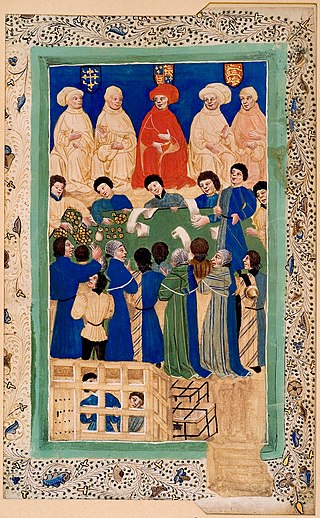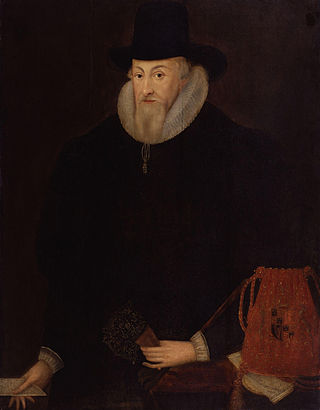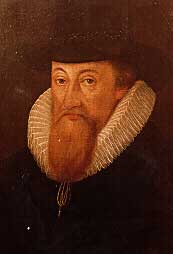
Sir Walter Mildmay was a statesman who served as Chancellor of the Exchequer to Queen Elizabeth I, and founded Emmanuel College, Cambridge.

Thomas Howard, 1st Earl of Suffolk, of Audley End House in the parish of Saffron Walden in Essex, and of Suffolk House near Westminster, a member of the House of Howard, was the second son of Thomas Howard, 4th Duke of Norfolk by his second wife Margaret Audley, the daughter and eventual sole heiress of Thomas Audley, 1st Baron Audley of Walden, of Audley End.

The Exchequer of Pleas, or Court of Exchequer, was a court that dealt with matters of equity, a set of legal principles based on natural law and common law in England and Wales. Originally part of the curia regis, or King's Council, the Exchequer of Pleas split from the curia in the 1190s to sit as an independent central court. The Court of Chancery's reputation for tardiness and expense resulted in much of its business transferring to the Exchequer. The Exchequer and Chancery, with similar jurisdictions, drew closer together over the years until an argument was made during the 19th century that having two seemingly identical courts was unnecessary. As a result, the Exchequer lost its equity jurisdiction. With the Judicature Acts, the Exchequer was formally dissolved as a judicial body by an Order in Council on 16 December 1880.

The Trial of the Pyx is a judicial ceremony in the United Kingdom to ensure that newly minted coins from the Royal Mint conform to their required dimensional and fineness specifications. Although coin quality is now tested throughout the year under laboratory conditions, the event has become an annual historic tradition. Each year, thousands of coins are put on trial, consisting of both those struck for circulation and non-circulating commemorative coins.
The Remembrancer was originally a subordinate officer of the English Exchequer. The office is of great antiquity, the holder having been termed remembrancer, memorator, rememorator, registrar, keeper of the register, despatcher of business. The Remembrancer compiled memorandum rolls and thus “reminded” the barons of the Exchequer of business pending.

Thomas Egerton, 1st Viscount Brackley,, known as Lord Ellesmere from 1603 to 1616, was an English nobleman, judge and statesman from the Egerton family who served as Lord Keeper and Lord Chancellor for twenty-one years.
Sir William Cockayne was a seventeenth-century merchant, alderman, and Lord Mayor of the City of London.

Sir Jonathan Frederick Pollock, 1st Baronet, PC was a British lawyer and Tory politician.
Peter Osborne, Esquire, (1521–1592) was an English officer of state who was Keeper of the Privy Purse to King Edward VI, at a time when great constitutional changes affected the management of public finance. Of reformist sympathies in religion, his career was in abeyance during the reign of Queen Mary but regained momentum as Remembrancer in the Exchequer under Elizabeth, working usually to his marital kinsman Lord Burghley. He also sat in seven parliaments between 1559 and 1589.

Thomas Fanshawe, 1st Viscount Fanshawe KB was an English politician who sat in the House of Commons at various times between 1621 and 1661. He supported the Royalist cause in the English Civil War. Following the Restoration he was raised to the peerage.

Thomas Fanshawe (1533–1601) was a Member of the English Parliament during the reign of Queen Elizabeth I. He also held the civil service post of Queen's remembrancer of the exchequer.
Sir Henry Fanshawe (1569–1616) was a Member of the English Parliament who held the office of Remembrancer of the Exchequer.

Sir Christopher Hatton KB was an English politician who sat in the House of Commons between 1601 and 1614. He was also an active patron of the arts, supporting composers such as Tobias Hume and Orlando Gibbons.

The Court of Exchequer (Ireland), or the Irish Exchequer of Pleas, was one of the senior courts of common law in Ireland. It was the mirror image of the equivalent court in England. The Court of Exchequer was one of the four royal courts of justice which gave their name to the building in Dublin in which they were located, which is still called the Four Courts, and is in use as a courthouse.
Sir Richard Lowther of Lowther Hall, Westmorland was an English soldier and official. He was twice High Sheriff of Cumberland and Lord Warden of the West March in 1592.

Thomas Fanshawe, 2nd Viscount Fanshawe (1632–1674) of Ware Park, Hertfordshire was an Irish peer and Member of Parliament. He was born to Thomas Fanshawe, 1st Viscount Fanshawe by his second wife Elizabeth Cockayne, the daughter of Sir William Cockayne, who served as the Lord Mayor of London in 1619.
The chief justice of Munster was the senior of the two judges who assisted the Lord President of Munster in judicial matters. Despite his title of Chief Justice, full judicial authority was vested in the lord president, who had "power to hear and determine at his discretion all manner of complaints in any part of the province of Munster", and also had powers to hold commissions of oyer and terminer and gaol delivery.

Henry Fanshawe (1506–1568) was a Member of the English Parliament during the reign of Elizabeth I. He also served as Queen's Remembrancer from 1565 to his death in 1568. Valence House Museum has a portrait of him that was donated by Aubrey Fanshawe.












